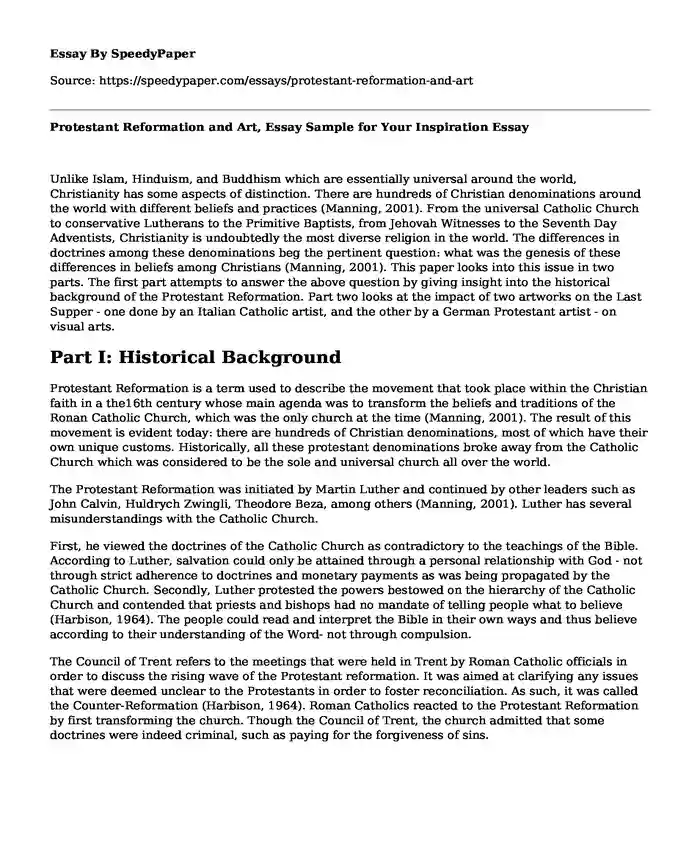
| Type of paper: | Essay |
| Categories: | History Arts Christianity |
| Pages: | 3 |
| Wordcount: | 643 words |
Unlike Islam, Hinduism, and Buddhism which are essentially universal around the world, Christianity has some aspects of distinction. There are hundreds of Christian denominations around the world with different beliefs and practices (Manning, 2001). From the universal Catholic Church to conservative Lutherans to the Primitive Baptists, from Jehovah Witnesses to the Seventh Day Adventists, Christianity is undoubtedly the most diverse religion in the world. The differences in doctrines among these denominations beg the pertinent question: what was the genesis of these differences in beliefs among Christians (Manning, 2001). This paper looks into this issue in two parts. The first part attempts to answer the above question by giving insight into the historical background of the Protestant Reformation. Part two looks at the impact of two artworks on the Last Supper - one done by an Italian Catholic artist, and the other by a German Protestant artist - on visual arts.
Part I: Historical Background
Protestant Reformation is a term used to describe the movement that took place within the Christian faith in a the16th century whose main agenda was to transform the beliefs and traditions of the Ronan Catholic Church, which was the only church at the time (Manning, 2001). The result of this movement is evident today: there are hundreds of Christian denominations, most of which have their own unique customs. Historically, all these protestant denominations broke away from the Catholic Church which was considered to be the sole and universal church all over the world.
The Protestant Reformation was initiated by Martin Luther and continued by other leaders such as John Calvin, Huldrych Zwingli, Theodore Beza, among others (Manning, 2001). Luther has several misunderstandings with the Catholic Church.
First, he viewed the doctrines of the Catholic Church as contradictory to the teachings of the Bible. According to Luther, salvation could only be attained through a personal relationship with God - not through strict adherence to doctrines and monetary payments as was being propagated by the Catholic Church. Secondly, Luther protested the powers bestowed on the hierarchy of the Catholic Church and contended that priests and bishops had no mandate of telling people what to believe (Harbison, 1964). The people could read and interpret the Bible in their own ways and thus believe according to their understanding of the Word- not through compulsion.
The Council of Trent refers to the meetings that were held in Trent by Roman Catholic officials in order to discuss the rising wave of the Protestant reformation. It was aimed at clarifying any issues that were deemed unclear to the Protestants in order to foster reconciliation. As such, it was called the Counter-Reformation (Harbison, 1964). Roman Catholics reacted to the Protestant Reformation by first transforming the church. Though the Council of Trent, the church admitted that some doctrines were indeed criminal, such as paying for the forgiveness of sins.
Part II: Impact on Visual Arts
The transformations that took place during the Protestant Reformation and the subsequent Counter-Reformation had a great impact on visual acts. For example, two artists worked on an artistic representation of the Last Supper (Manning, 2001). One was an Italian Catholic artist called Tintoretto who interpreted the last supper as the final moment that Jesus spent with his disciples before the crucifixion. To him this the betrayal of Jesus by Judas at this time was synonymous with the events of protestant reformation (Manning, 2001). The other artist was Albrecht Durer, a German Protestant who deviates from the Eucharist controversy of bread and wine. His artwork shows that Judas is absent and Jesus is giving the new commandment of love. This illustrates Luther's interpretation of the Bible.
References
Harbison, E. (1964). THE PROTESTANT REFORMATION. In Christianity and History: Essays (pp. 141-156). Princeton University Press. Retrieved from http://www.jstor.org/stable/j.ctt183prb9.10
Manning, P. (2001). The History of Cobbett's "A History of the Protestant "Reformation' ". Huntington Library Quarterly, 64(3/4), 429-443. doi:10.2307/3817920
Cite this page
Protestant Reformation and Art, Essay Sample for Your Inspiration. (2022, Oct 18). Retrieved from https://speedypaper.com/essays/protestant-reformation-and-art
Request Removal
If you are the original author of this essay and no longer wish to have it published on the SpeedyPaper website, please click below to request its removal:
- Anna Reid's Critique - Free Essay Sample
- Philosophy Essay Example With Questions
- American Sniper
- Free Essay on HR Policies of Alabama Medicaid Agency
- Research Paper Sample on the Levels of Vitamin D in Patients with Graves Disease
- Paper Yample: Eradicating Selective Communication of Information
- Free Essay Example: Causes of Nurse Burnout
Popular categories




